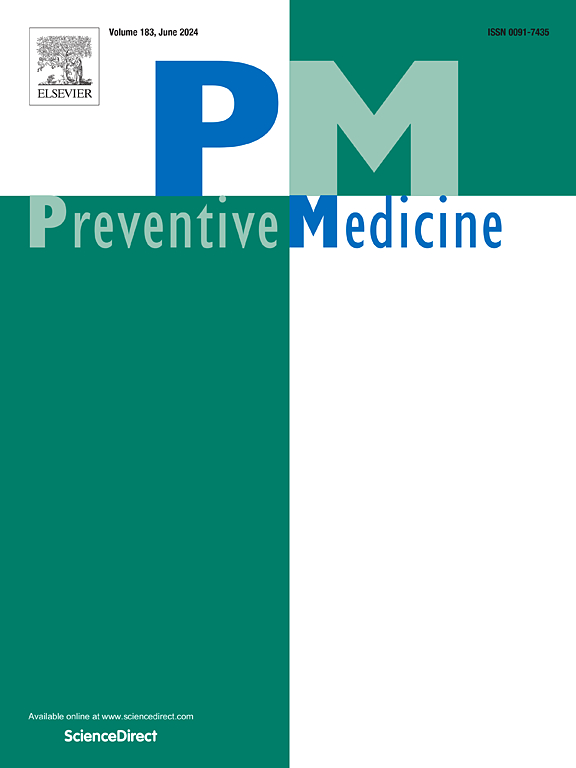Disability and receipt of the Papanicolaou test for cervical cancer screening: A systematic review and meta-analysis
IF 3.2
2区 医学
Q1 MEDICINE, GENERAL & INTERNAL
引用次数: 0
Abstract
Objective
To synthesize literature comparing Papanicolaou (Pap) test receipt between women with and without disabilities.
Methods
We searched the following databases from inception to March 1, 2024: OVID Medline (1946–), EBSCO CINAHL Plus (1981–), OVID EMBASE (1974–), and OVID APA PsycINFO (1806–). Eligible studies were peer-reviewed and compared receipt of Pap tests in women with physical, hearing, vision, or intellectual/developmental disability versus those without disabilities. We extracted data using a standardized form; study quality was appraised using the Newcastle-Ottawa Scale; and results were synthesized using random-effects meta-analyses, where possible. Findings that could not be meta-analyzed were summarized following Synthesis Without Meta-analysis guidelines. Grading of Recommendations, Assessment, Development and Evaluation was used to assess the strength of evidence.
Results
Of 1946 unique studies screened, 43 were included in the review, and 21 were meta-analyzed. Studies were primarily cross-sectional (65.1 %), used survey data (76.7 %), and were conducted in the United States (60.5 %). Quality was rated high (30.2 %), medium (55.8 %), and low (14.0 %). Women with disabilities had a lower likelihood of receiving a Pap test (adjusted pooled OR 0.78, 95 % CI: 0.66–0.91). Disparities were more pronounced among those with physical (adjusted pooled OR 0.74, 95 % CI: 0.68–0.80) and intellectual/developmental disabilities (adjusted ORs ranging from 0.21 to 0.37). The overall strength of evidence was low.
Conclusions
Women with disabilities could benefit from efforts to improve cervical cancer screening receipt. Future studies should continue to explore this association, including using population-based data that may better capture the needs of this group.
残障和接受帕帕尼科劳试验用于宫颈癌筛查:一项系统回顾和荟萃分析。
目的:综合文献比较残疾妇女和非残疾妇女接受巴氏涂片检查的情况。方法:检索OVID Medline(1946-)、EBSCO CINAHL Plus(1981-)、OVID EMBASE(1974-)和OVID APA PsycINFO(1806-)数据库。符合条件的研究经过同行评审,并将接受巴氏试验的身体、听力、视力或智力/发育残疾妇女与无残疾妇女进行比较。我们使用标准化表格提取数据;采用纽卡斯尔-渥太华量表评价研究质量;在可能的情况下,使用随机效应荟萃分析来综合结果。不能进行meta分析的研究结果按照不进行meta分析的综合指南进行总结。建议、评估、发展和评价的分级用于评估证据的强度。结果:在筛选的1946项独特研究中,有43项纳入本综述,21项进行了meta分析。研究主要是横断面(65.1 %),使用调查数据(76.7 %),并在美国进行(60.5 %)。质量被评为高(30.2% %)、中(55.8% %)和低(14.0% %)。残疾妇女接受巴氏试验的可能性较低(调整后的合并OR为0.78,95 % CI: 0.66-0.91)。在身体残疾(调整后的综合OR为0.74,95 % CI: 0.68-0.80)和智力/发育残疾(调整后的OR为0.21至0.37)患者中,差异更为明显。证据的总体强度很低。结论:残疾妇女可以从改善宫颈癌筛查接收的努力中受益。未来的研究应继续探索这种联系,包括使用基于人口的数据,以更好地捕捉这一群体的需求。
本文章由计算机程序翻译,如有差异,请以英文原文为准。
求助全文
约1分钟内获得全文
求助全文
来源期刊

Preventive medicine
医学-公共卫生、环境卫生与职业卫生
CiteScore
7.70
自引率
3.90%
发文量
0
审稿时长
42 days
期刊介绍:
Founded in 1972 by Ernst Wynder, Preventive Medicine is an international scholarly journal that provides prompt publication of original articles on the science and practice of disease prevention, health promotion, and public health policymaking. Preventive Medicine aims to reward innovation. It will favor insightful observational studies, thoughtful explorations of health data, unsuspected new angles for existing hypotheses, robust randomized controlled trials, and impartial systematic reviews. Preventive Medicine''s ultimate goal is to publish research that will have an impact on the work of practitioners of disease prevention and health promotion, as well as of related disciplines.
 求助内容:
求助内容: 应助结果提醒方式:
应助结果提醒方式:


